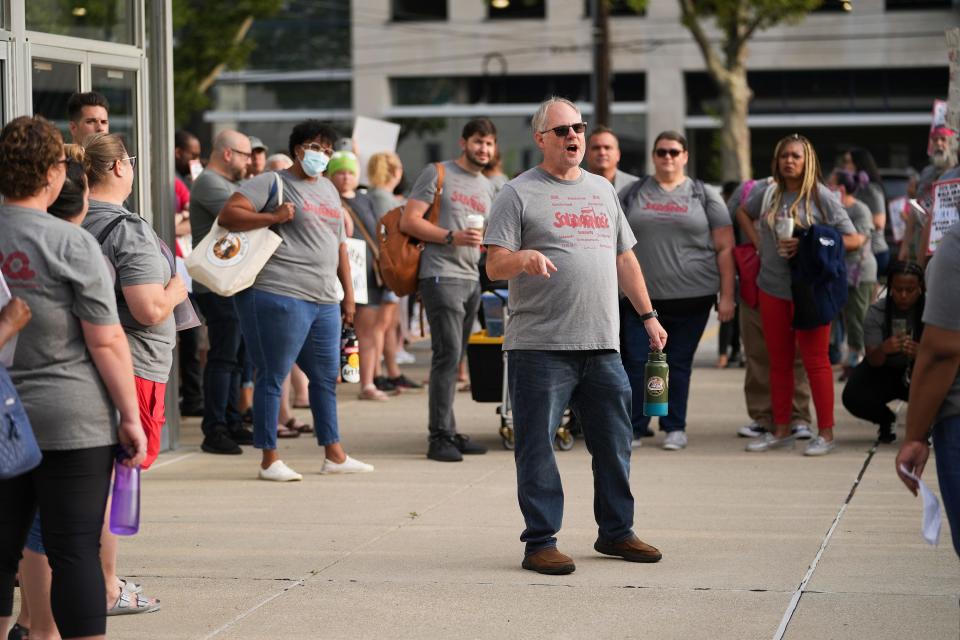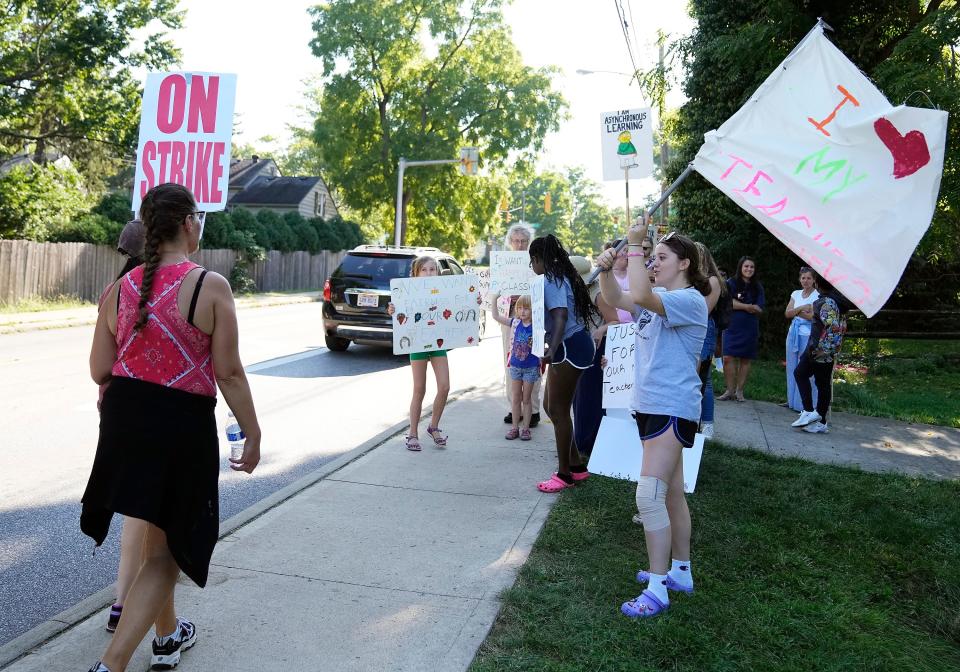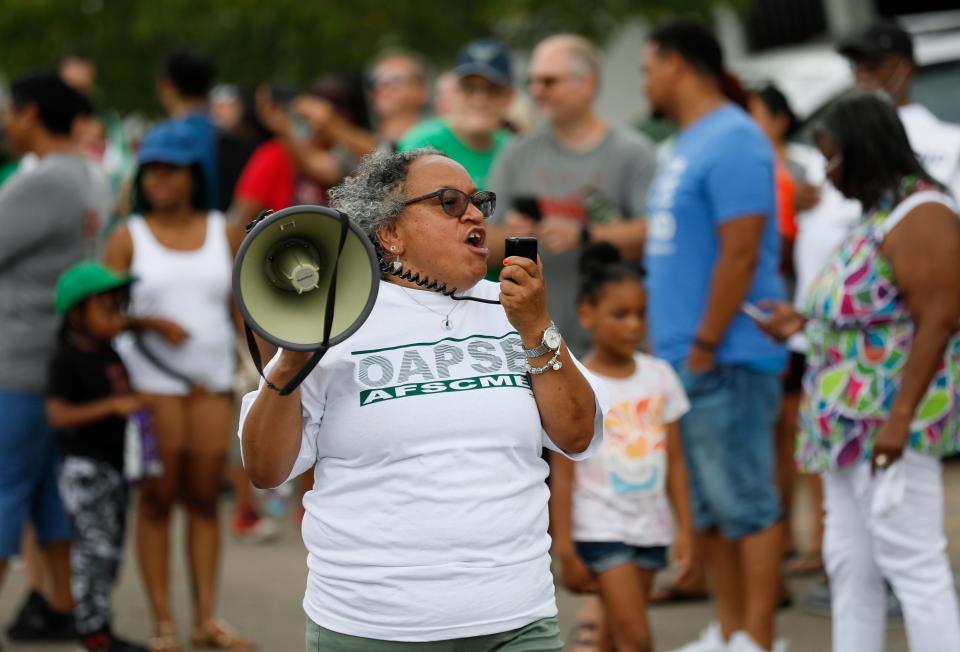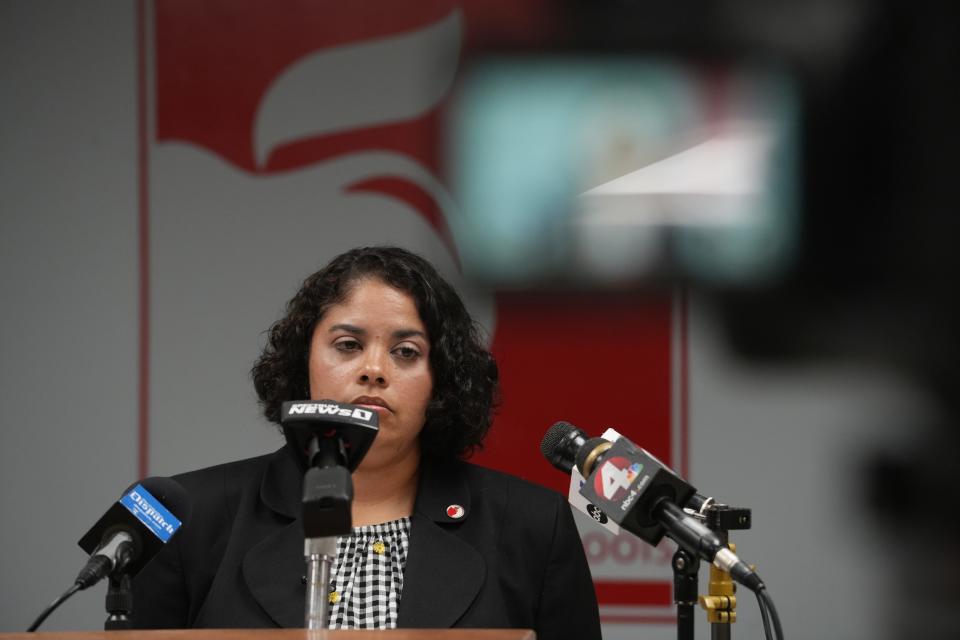Cooperation improved year after Columbus CIty Schools teachers strike

About this time last year, Columbus experienced something it hadn't for nearly 50 years — a teacher's strike at the state's largest public school district.
At campuses across Columbus City Schools, hundreds of teachers, librarians, nurses and counselors in the Columbus Education Association (CEA) lined up along with some students and parents on the scheduled first day of classes and waved picket signs calling for the Board of Education to come to the negotiating table.
Just three days earlier, more than 94% of the roughly 4,800 CEA members who attended a mass meeting at the Greater Columbus Convention Center voted to reject the school board's last and final offer. The district had previously offered a 3% pay bump, but refused to guarantee air conditioning in schools — an issue that would become central to the strike.
The three-day strike, which focused on building conditions, class sizes and pay, threw the first week of the 2022-23 school year into disarray, and left students and parents scrambling to find accommodations for their first day of online classes, which were taught by substitutes.
With the new school year set to begin on Wednesday, some are asking how Columbus City Schools has addressed the issues that sparked the strike and how things have changed since then.
"There's a recognition now that we need to do things differently, we need to cooperate," said John Coneglio, president of the Columbus Education Association. "Sometimes it takes drastic measures to show that 'Hey, we're serious about wanting to fix issues,' and I think it was a wake-up call for everybody."
'A huge storm'
The contract agreement, approved by the CEA the weekend following the strike, included pay raises (guaranteed 3% annual increases for three years among other concessions), smaller class sizes in grades K-5, and guarantees that all 112 of its schools would have air conditioning by the 2025-26 school year.
More: Timeline of the CEA union strike and Columbus City Schools contract: How we got here

Board President Jennifer Adair said the strike laid bare to the community the kinds of issues and challenges that teachers face every day in Columbus and across the nation, from less-than-ideal building conditions to the rigors of the job.
"We were all dealing, and still are, with huge systemic problems that face the district," Adair recently told The Dispatch. "It didn't get this way overnight, and we're not going to get out of it overnight."
Looking back with photos: Columbus City Schools teachers strike; walk picket lines
Still, the district has worked hard to live up to its commitments and will continue to do so, Adair said.
At Tuesday's board meeting, Superintendent Angela Chapman told trustees that more than 99% of the district's schools have air conditioning for the upcoming year. Only Mifflin Middle School's HVAC system is still under construction, and that's expected to be completed by next summer.
As for teaching levels, Chapman said that only 27 out of 2,676 classroom teacher positions (1%) are currently vacant. The district has 69 openings among special education teachers, representing 11% of the 623 total positions.
Chapman, who became superintendent after the strike and was a senior administrative leader before that, told The Dispatch that the district has overcome several challenges in the past three years, including the strike, the COVID-19 pandemic and leadership change.
"The teachers' strike was a huge storm that we weathered together," Chapman said. "But that's behind us now. And so now we recognize that we're stronger together, we're stronger because of all those experiences."
Coneglio said he is looking forward to seeing the fruits of the negotiations, especially in terms of reduced class sizes and opportunities to improve learning in ways that involve students' parents and families.
"I believe we came to a successful resolution," Coneglio said of the strike. "We're excited to see what this year brings. ... It's a different feel."
What ended the strike
Coneglio and Adair agree: the turning point in the strike negotiations was the Columbus community support for district teachers.
"If it wasn't for the community saying 'Hey, you get back together and negotiate with teachers in good faith'" Coneglio said of the stalled negotiations. "When the community said that — that's what moved things forward."
During the strike, some parents said they wouldn't allow their students to log on and cross the "virtual picket line," despite warnings by the district that unexcused absences could lead to truancy action. Other parents and their children joined teachers on the picket lines alongside district staff members.

"We saw the way that our community came out and supported our staff and our teachers," Adair said.
Since strike, unions representing Columbus City Schools employees have added membership
Columbus City Schools employees are represented by two labor unions: the CEA, with more than 4,800 education professionals. and the Columbus Schools Employees Association (a bargaining unit of the Ohio Association of Public School Employees), which represents over 3,200 custodians, bus drivers, secretaries and other support staff.
Since the strike, the CEA and OAPSE have added units to their unions, expanding the types of employees the groups represent; the CEA has added building substitute teachers and OAPSE added district safety and security staff.
"We're in a situation now where there is a teacher shortage, we can't find bus drivers. We need instructional assistants," Coneglio said. "Public education is in a crisis."
While Columbus City Schools and districts across the country have many challenges ahead, "we all realized we need to do things differently," Coneglio said.
OAPSE and CSEA President Lois Carson said the union is hoping to add even more groups to their bargaining unit.

Michelle Kaminski, a Michigan State University professor specializing in labor relations and collective bargaining, said labor unions are experiencing the highest popularity they’ve had since 1965.
“The shortage of workers has given labor unions and employees, more broadly, much more power and influence than they had five years ago or 10 years ago,” she said.
Two months ago, the CSEA signed a new contract with the district that includes raises and expanded benefits over the next three years. Carson said the negotiating process this time around was refreshing compared to previous years. She cited Chapman opening up the negotiations herself, which helped set a positive tone.
"We're starting to have a seat at the table … and we're just hoping that we continue to move forward on that movement," she said.
'A breath of fresh air'
Adair said she is confident the district and new administration will be able to continue repairing and strengthening relationships with everyone affected by the strike, including the unions.
"Are we going to agree on everything every day? No, we're not," Adair said. "And that's why there are labor unions."

Chapman said she has "been intentional about strengthening these relationships and improving the culture and climate."
"We are working through a culture shift. We are shifting from that 'command and control, do as I say' (approach) to 'trust and inspire,'" Chapman said. "We are the ones who are going to make a difference in the lives of our students."
Kaminski said it’s not typical for relations to improve following a strike, but management leadership changes can shift the dynamic.
“Negotiations can be difficult, and some of the stress and tensions can carry forward even after a successful contract negotiation without a strike,” Kaminski said.
Jake Rosenfeld, a sociology professor at the Washington University in St. Louis, said new leadership often results in a "honeymoon period" between administration and labor after tough negotiations.
"How long that lasts, and whether one side or the other kind of walks away from cooperation, and how long that takes, certainly varies," Rosenfeld said. "But I think everyone, especially after kind of a bruising battle — is at least at first — oftentimes willing to give that new leadership the benefit of the doubt going forward."
Carson said she felt "morale in the district is starting to see a shift."
'I think right now, the district has a plan and a vision," she said. "And I think we're all moving forward together, not separate."
A year after the historic strike, union leadership say they're excited to work with Chapman in the coming school year to benefit students.
"She's been very responsive to our teachers, I think she's genuinely listening," Coneglio said of the new superintendent. "We're working collaboratively. It is really a breath of fresh air."
@Colebehr_report
Cbehrens@dispatch.com
This article originally appeared on The Columbus Dispatch: Columbus schools, teachers union looking to better future a year after strike,

